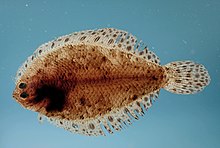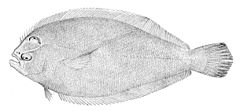Paralichthyidae
| Large-tooth flounders | |
|---|---|

| |
| Pacific sanddab, Citharichthys sordidus | |
| Scientific classification | |
| Domain: | Eukaryota |
| Kingdom: | Animalia |
| Phylum: | Chordata |
| Class: | Actinopterygii |
| Order: | Pleuronectiformes |
| Suborder: | Pleuronectoidei
|
| Family: | Paralichthyidae Chabanaud, 1937 |
| Type genus | |
| Paralichthys Girard, 1858
| |
| Genera[1] | |
|
Ancylopsetta | |
Large-tooth flounders or sand flounders are a family, Paralichthyidae, of

They are found in

Several species are important commercial and game fishes, notably the California halibut, Paralichthys californicus and the Pacific sanddab, Citharichthys sordidus.
Phylogenetic analyses have long indicated the non-monophyly of this family e.g.,[4] and two lineages have been consistently apparent. Termed groups, the two groups were named after genera: a Cyclopsetta group and a Pseudorhombus group (see summary in [5]). A formal description of Cyclopsettidae in 2019 created this family consisting of four genera: Cyclopsetta, Etropus, Citharichthys, and Syacium corresponding to the previously recognized Cyclopsetta group.[5] Molecular phylogenetic evidence indicates that Paralichthyidae in this sense is sister to Pleuronectidae and Cyclopsettidae is sister to Bothidae e.g.[6]
References
- ^ a b Froese, Rainer, and Daniel Pauly, eds. (2012). "Paralichthyidae" in FishBase. October 2012 version.
- ISBN 978-0-8018-9838-9
- ^ "Paralichthyidae" World Register of Marine Species. Retrieved 2014-1-26.
- ISSN 1886-8134.
- ^ S2CID 202856805.
- S2CID 86091999.
